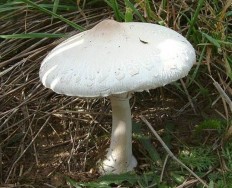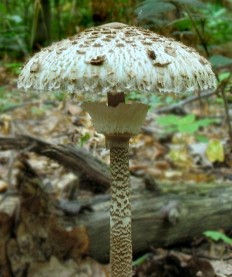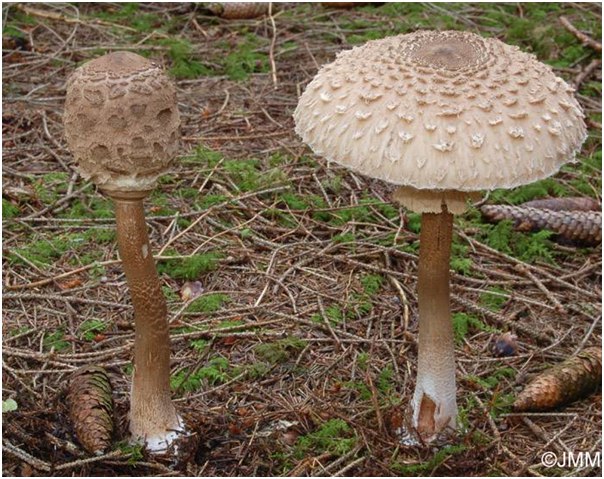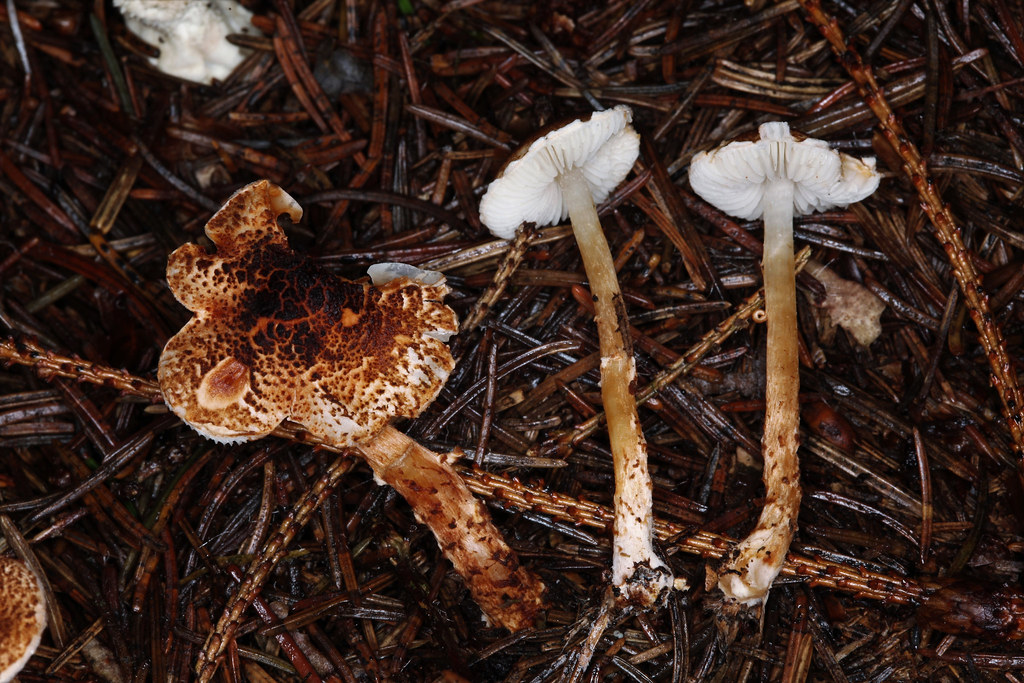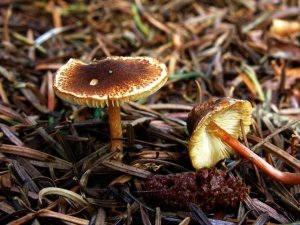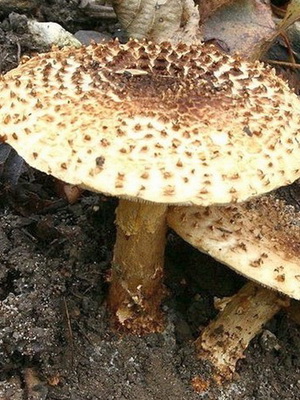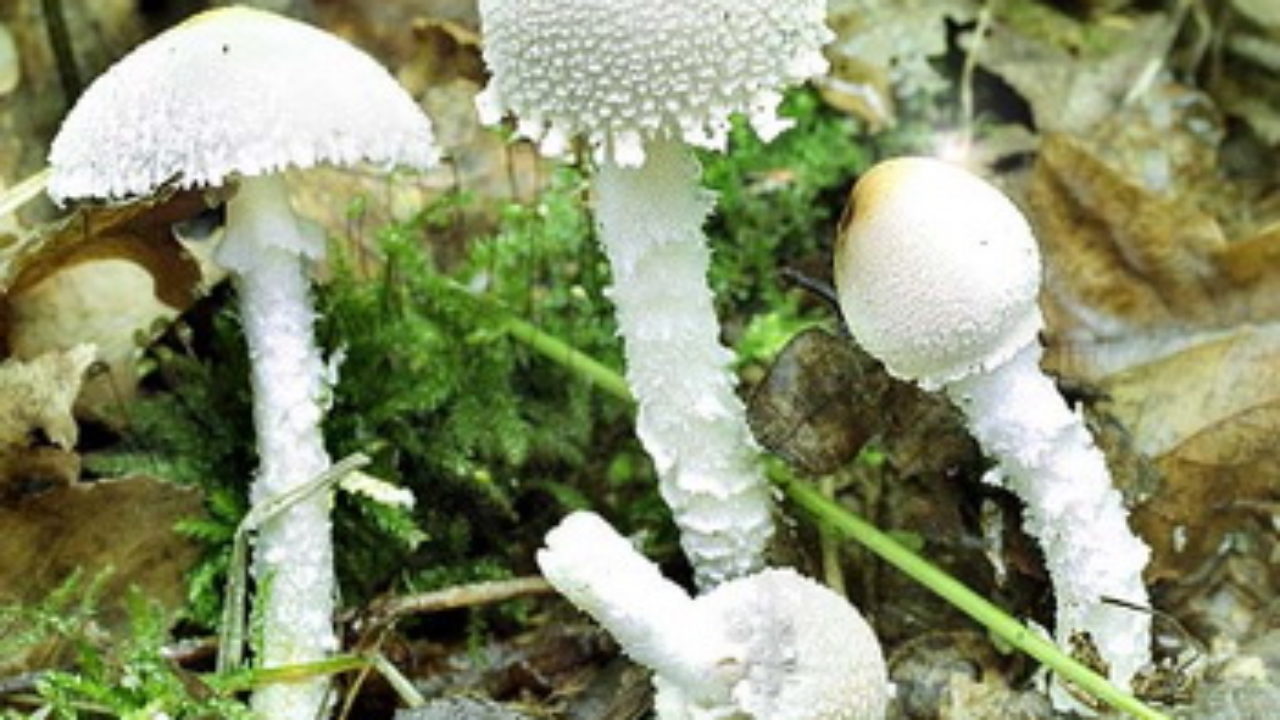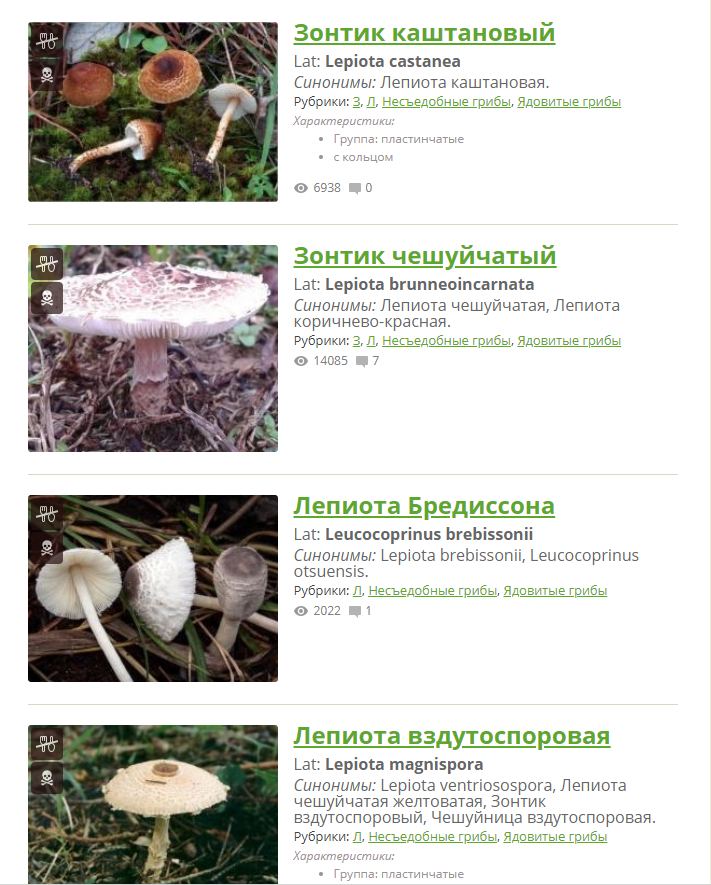Umbrella mushrooms - edible: varieties, description, photo
As you already understood, not all umbrella mushrooms are edible. Among this species there are also poisonous representatives that can harm the human body. That is why now we will introduce you to the edible types of umbrellas. They can be easily harvested throughout the mushroom season and consumed after heat treatment.
Types of edible umbrella mushrooms:

White.
This species has another name - field. They call it that because of the color and place of growth. As you probably already understood, its pulp is light in color. It can be white, cream or light gray. Initially, this species has an egg-shaped cap, which eventually opens and becomes like an umbrella. Most often it can be found in meadows, fields and open forest edges.
 Motley.
Motley.
This type of umbrella is usually quite large. The cap of the mushroom is completely dry and covered with characteristic brown scales. Also on the cap, small growths of dark brown color are clearly visible. That is why this type of umbrella has a darker shade than other relatives. The pulp of the variegated umbrella is cotton-like, with a pronounced nutty smell. Likes to grow in open, well-lit areas.

 Blushing
Blushing
... The cap of this type of umbrella has a gray or brownish tint and a thin, almost white stem, which, as the fungus grows, darkens and thickens at the base of the soil. The mushroom got its name because of the ability of the pulp to oxidize. If you break the hat of the umbrella, then droplets of juice will appear on it almost immediately, which will very quickly turn from transparent to reddish-brown. In addition, the red umbrella has more developed scales. Since visually they resemble a kind of fringe, sometimes a blushing umbrella is called shaggy. For growth, it chooses soil that is useful for nutrients.
 Maiden.
Maiden.
This type of umbrella is listed in the Red Book, so it is almost impossible to find it in our forests. The mushroom differs from its relatives in that it does not grow to large sizes. As a rule, the hat, even in adult representatives, has a diameter of no more than 10 cm. A girl's umbrella has a light shade of pulp and a not very pronounced mushroom aroma.
Mastoid.
Has a matte light brown cap, the edges of which are lowered down. In the dry season, the skin on the cap begins to crack and a peculiar pattern forms on it. The main difference between the mastoid umbrella and other relatives is the presence of a pronounced tubercle in the very center of the cap. Visually, it resembles a brownish nipple.
How to cook
Cooking umbrella mushrooms is quick and easy, because they can even be eaten raw in salads or on sandwiches. They are fried, stewed, soups are boiled with them, salted, pickled and dried.
Umbrella mushrooms in batter
Ingredients of the dish:
- Mushrooms - 500 grams;
- Flour - 2 tablespoons;
- Egg - 3 pieces;
- Onion (medium) - 2 pieces;
- Cheese (hard varieties) - 200 grams;
- Vegetable oil - 5 tablespoons;
- Table vinegar - 1 tablespoon;
- Salt, black pepper.

Cooking method:
- Peel the onion, cut into thin half rings, add vinegar, sprinkle with salt and leave to marinate for half an hour.
- Clean, wash and dry the mushroom caps.
- Beat eggs with flour, salt and pepper.
- Cut large mushrooms into several pieces.
- Heat oil in a large frying pan, dip each piece of mushroom in batter and fry on both sides for a few minutes.
- Put the onion on the mushrooms.
- Grate the cheese on a coarse grater, pour it into a pan on the onions with fried mushrooms, turn off the heat and hold them on the stove for about five minutes so that the cheese melts.
The umbrella mushroom is one of the most delicious representatives of the mushroom kingdom.It is considered one of the varieties of champignons, although it differs from them both in appearance and in taste. It belongs to the group of saprophytes, that is, those that grow on decaying organic debris. This mushroom is distributed all over the world, and in our country there are five of its varieties.
Despite such features, many mushroom pickers do not take it. Maybe because an edible umbrella mushroom looks like a fly agaric? But knowledgeable mushroom pickers are happy to collect young umbrellas, which grow in one place every year. Those who want to taste the pleasant nutty taste of this mushroom need to know how to distinguish it from poisonous ones, where it grows and how to cook it properly.
How to distinguish an umbrella mushroom from a champignon?


In principle, anyone can distinguish an umbrella mushroom from an ordinary mushroom. We most often see this type of champignons on store shelves, so there should be no difficulties. Most often, such a champignon chooses meadows, fields, orchards and even vegetable gardens for growing. It has a white flesh and a hemispherical forum of the cap. The edges of the cap are connected to the stem with a white foil. As you can see, visually the champignon is very different from the umbrella mushroom.
However, it should be borne in mind that there are two more types of champignons - forest and field. They are visually more like an umbrella mushroom. They have a more outstretched cap with a barely noticeable tubercle in the very center. Perhaps the most noticeable difference between these two forest dwellers is the color and smell of the pulp. As for the smell of champignons, as a rule, it is almond. The color is initially also white, but if the mushroom is cut, it will begin to turn pink, and then the cut will turn reddish or grayish.
Poisonous Umbrella Mushrooms
Among the numerous genus Macrolepiota, there are specimens that almost do not differ from the edible in appearance, but are considered poisonous. These include the umbrella comb, chestnut, fleshy red, brownish red and rough. The most dangerous are the first 2 types.
Chestnut

Chestnut lepiota has a red or brown head, the diameter of which does not exceed 4 cm. The head of the chestnut umbrella mushroom at a young age has an ovoid shape, then takes the form of a prostrate dome. A small tubercle remains in the center. Gradually, the skin of the cap cracks, small scales and brownish color are formed.
As the plates grow, they turn yellow. The reddish or brown flesh is highly fragile and has an unpleasant odor. The leg is in the form of a narrow cylinder, expanding closer to the base. The ring is white, but gradually becomes thinner and disappears completely.
The chestnut umbrella is very poisonous, in most cases the use of this product in food is fatal.
Comb
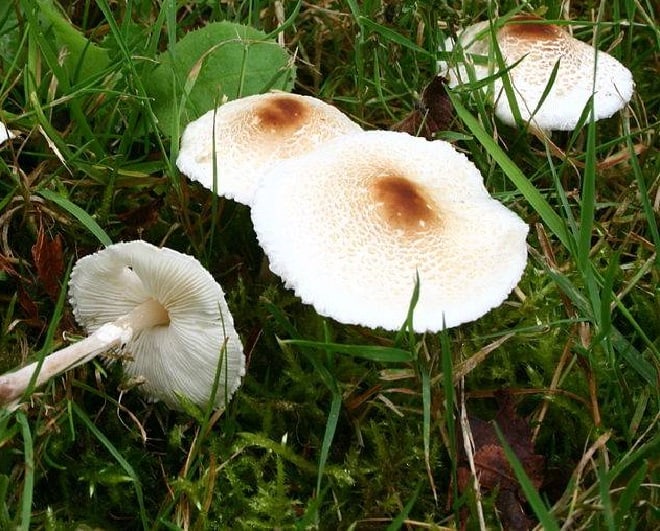
The hat of young umbrellas is bell-shaped, later becoming like a wide dome up to 10 cm in diameter. Its surface is red-brown or dark brown, covered with orange or yellow scales with sharp tips.
The leg in the upper part is cylindrical, hollow, thin, 7-10 cm high and no more than 5 mm in diameter. It differs in a variety of tones - from yellow to cream, but it can also have a brown tint. In young specimens, a wide membranous ring is clearly visible, white or pink, but quickly disappears as it grows.
The pulp of the mushroom is white, has an unpleasant odor and taste.
Crested lepiota is a poisonous species and is not eaten.
Rough

The cap of a scaly lepiota is capable of reaching 15 cm in diameter, bell-shaped. As they grow older, it becomes prostrate or convex, with a wide tubercle in the central part. The surface of the cap is very dry, reminiscent of felt. Color - from yellowish to light brown. The scales are darker, pyramidal, and large.
The blades of the umbrella mushroom are under a white blanket, which later transforms into a thin, white, cobweb ring with brown scales on the lower part. The color of the plates is from white to cream.
The stem, which has a tuberous shape at the base, is thin (10-15 mm) and long (up to 12 cm), hollow. Above the ring it is distinguished by a light shade, under it - yellow or brownish, fibrous, covered with scales, cylindrical in shape.
The pulp of Lepiota rough has an unpleasant, strong resinous odor and a bitter taste. Not used for food.
How to prepare umbrellas?
This is one of the most delicious mushrooms and is very easy to prepare. Umbrellas can be fried immediately after cleaning and rinsing under running water.

They are very tasty with potatoes and onions or simply fried in sunflower oil. An unusual dish is obtained by baking umbrellas in the oven with herbs and garlic. Gourmets will like it if they soak the bends in milk for several hours before frying, and then boil a little and let the water drain. You can cook soup from umbrellas, salt them, dry and marinate. They are prepared very quickly, the only condition is that you only need to eat young hats. Legs are not eaten as they are very tough and fibrous. In an old umbrella, the pulp becomes unfit for food. Having tasted this delicious mushroom once, you will never forget its pleasant and unusual nutty taste.
There are many mushroom lovers, but not everyone knows how to pick them. Many pass by such a delicious mushroom, collecting conditionally edible ones.
From our article you will find out if the umbrella mushroom is edible, get acquainted with its varieties, and also learn where to collect it and how to process it correctly.
Each of us at least once in our life has seen a mushroom resembling a pale toadstool at the edges, in groves, in mixed deciduous forests. Most people just bypass it and never put it in their wallet. But as practice shows, in most cases, people come across a very tasty and healthy umbrella mushroom.
Yes, he also has poisonous counterparts that are not suitable for food, but if you know how to distinguish these two types of mushrooms, then you can safely collect umbrellas and cook delicious dishes from them. In our article, we will introduce you to the edible and poisonous types of umbrellas, and also teach you how to distinguish them accurately.
Edible Umbrella Mushrooms
In the groves, forests and fields of our country, there are four types of edible umbrella mushrooms, there are also several poisonous varieties.
White
Umbrella mushroom white or field (Macrolepiota excoriata) is characterized by a grayish-white or creamy fleshy, scaly cap, initially ovoid and becoming flat as it grows. The plates are located frequently and freely. In young mushrooms, they are white in color, which eventually turns brown or brown.
The height of the hollow, slightly curved, cylindrical white leg ranges from 5 to 15 cm. When pressed, it turns brown. The white pulp has a light, pleasant aroma and does not change color when cut. Fruiting occurs at the end of June and lasts until mid-autumn.

Blushing
The cap of an umbrella mushroom blushing or shaggy (Chlorophyllum rhacodes) can be gray, beige or light brown in color and reach a diameter of 7 to 22 cm.Initially, it resembles an egg in shape, later becomes bell-shaped, and at the end of growth it is completely flat. Smooth, hollow legs grow from 6 to 25 cm in height and eventually turn darker in color.
The white or cream-colored plates turn pink or orange when touched. The white flesh of the cap with reddish-brown stains breaks easily and separates into fibers. She has a pleasant smell and a peculiar taste.

Motley
The diameter of the cap of the variegated umbrella mushroom (Macrolepiota procera) ranges from 15 to 30 cm.
It is characterized by a fibrous, loose flesh of white, grayish or beige color and dark brown scales.Young mushrooms have a hemispherical cap with a dark tubercle in the center, which over time straightens out and resembles an umbrella.

Maiden
The girl's umbrella mushroom (Leucoagaricus puellaris) has a cap with a diameter of 5 to 10 cm.
Initially, it is ovoid, and then becomes bell-shaped with a small tubercle in the center. Its edges are fringed. The skin of the white cap is densely covered with cream-colored scales, which become darker during the growth of the fungus. The white flesh turns reddish when cut.
Smooth, hollow, cylindrical legs, up to 15 cm high and up to 1 cm thick, taper at the top and thicken at the bottom. Plates are characterized by frequent and loose placement
... This type of mushroom has a pungent smell, and the taste is much weaker than the rest. Fruiting lasts from August to October.

Poisoning signs and first aid
The danger of the fungus for humans is not only when it is eaten. Inhalation of its spores causes severe damage to the tissues of the lungs and bronchi. When the fruiting body is consumed inside, the symptoms of poisoning develop within 10 minutes. A lethal dose of toxins will be obtained by eating only one mushroom cap. Even with urgent medical attention, 50% of those poisoned die. In treatment, hemodialysis and blood transfusion are used, but these methods are also not effective enough.
The clinical picture is developing rapidly. Death occurs within 30-60 minutes from the moment the first symptoms appear, which is why medical assistance is often simply not effective. The main manifestations of poisoning are the development of seizures and the release of copious foam from the mouth due to rupture of the alveoli.
There are no effective first aid methods due to the rapid absorption of toxins in the intestines. Reception of sorbents and gastric lavage do not bring results. The only thing that increases the victim's chances of survival is to call an ambulance at the first manifestations of poisoning.
(umbrella chestnut)
or fiery lepiota, shod with fire, Kele
✎ Affiliation and generic features
Chestnut lepiota (Latin Lepiota castanea) and otherwise - fire lepiota, or Kele lepiota and chestnut umbrella are a species of the genus Lepiota (silverfish) (Latin Lepiota) and the mushroom family (Agaricaceae) (Latin Agaricaceae), an extensive order of agaric (lamellar ) (lat.Agaricales).
First, the type of chestnut lepiota was described back in 1880 by Lucien Kele - the world famous French mycologist and naturalist, the discoverer of many types of mushrooms and the founder of the French Mycological Society, for which this type of lepiota received its unspoken name - Kele lepiota.
Chestnut Lepiota belongs to poisonous mushrooms, and contains in its composition unexplored toxins that can cause light and severe poisoning!
For these reasons, as well as because of the kinship with its relatives, containing amotoxins in the composition, which cause terribly severe poisoning of the stomach or liver, even fatal, it is considered a very dangerous poisonous mushroom!
✎ Similar views
Chestnut Lepiota has many similar twins, namely among its relatives, it differs from them mainly in a chocolate-red-brown hat with dark scales located in concentric circles, connecting in the center and forming a continuous brownish-purple cover.
Chestnut lepiota can be confused with cystoderm fungi (especially with deceptive cystoderm), suitable for human consumption (but this is already incomprehensibly dangerous), from which chestnut lepiota differs in the same scales merging in the center of the cap and forming a closed cover of brownish-crimson color. which are absent in cystoderms, and the absence of a membrane ring on the pedicle, which is perfectly noticeable in cystoderms, and the larger size of the fruiting body.
✎ Distribution in nature and seasonality
Chestnut Lepiota grows in deciduous and mixed forests, in gardens, along forest roads, ditches and ravines, on the soil, in very small groups and not often.
Chestnut lepiota is widespread in the lands of Western Europe, North America or in the northern regions of Russia, for example, in the forests of the Leningrad, Arkhangelsk regions or in Karelia, and also in the south of the northern temperate zone, capturing the European part of Russia, Western and Eastern Siberia.
Active growth in chestnut lepiota begins in summer, in June, and continues until the end of August - early September, and occasionally in spring, in late April - early May, or in autumn, mid-October and early November.
✎ Brief description and application
Chestnut lepiota is included in the section of lamellar mushrooms and the spores with which it reproduces are stored in its plates. The plates are wide and loose, yellowish-white, and slightly redden when ripe. The cap is small, bell-shaped as it grows, it becomes rounded-convex, with edges slightly lowered inward, chestnut or crimson-brown in color, covered with hard, fibrous scales, wine-brownish tone, located chaotically. The stem is cylindrical, not long, dense and slightly swollen at the very base, clearly the same color as the cap, with a distinctive but rapidly disappearing fibrous ring of whitish color. The pulp is massive, in the cap and stem is yellowish-white, and under the skin, at the cap, it is already a little reddish.
It is forbidden to taste serrata lepiota, it is terribly poisonous !!!
Inedible and poisonous mushrooms umbrellas: types and photos
Among the umbrellas, there are not only edible, but also inedible, as well as poisonous mushrooms from the genus Lepiota, the description of which is presented below:
Crested lepiota (silverfish, comb umbrella) (Lepiota cristata, Agaricus cristatus)
inedible mushroom, sometimes defined as poisonous.
The cap of the mushroom is 2 to 5 cm in diameter, bell-shaped in young mushrooms and convex-prostrate in mature specimens. The color of the cap is red-brown, its surface is covered with pointed, sparsely located scales of a yellow-orange or ocher tone. The stem of the poisonous umbrella mushroom is thin, hollow, up to 8 cm high, up to 0.5 cm in diameter, cylindrical, slightly widened at the base. The color of the stem varies from yellowish to light cream, the ring is whitish or pinkish, very narrow and disappears quickly enough. The pulp of the mushroom is white, fibrous, has a sour taste and a pungent, unpleasant odor.
The poisonous crested umbrella mushroom is a typical representative of the northern zone with a temperate climate.

Photo by: Strobilomyces

Photo Credit: Jean-Pol GRANDMONT

Photo Credit: Jean-Pol GRANDMONT
Chestnut Lepiota (chestnut umbrella) (Lepiota castanea, Lepiota ignipes)
a poisonous mushroom with a cap with a diameter of 2-4 centimeters, which has a reddish-brown tint. The shape of the cap is ovoid in young umbrellas and outstretched in adult mushrooms. With age, the smooth skin of the cap cracks into small chestnut flakes. The cylindrical stem of the chestnut umbrella is slightly widened and pubescent at the base, the flesh of the mushroom is white, fragile, with an intense unpleasant odor. The flesh of the leg has a reddish brown tint. The ring is narrow and white, and disappears rather quickly. Thin and frequent plates of the fungus are initially white, which turns yellow over time.
The poisonous umbrella mushroom chestnut grows in temperate zones, is widespread in Europe, often found in Western and Eastern Siberia.


Rough lepiota (umbellate scaly) (Lepiota aspera, Agaricus asper, Lepiota acutesquamosa)
inedible mushroom. The mushroom cap is fleshy, 7 to 15 cm in diameter, yellowish brown or brick-colored. In young specimens, it is fleecy-tomentose, has the shape of an egg, becomes prostrate with age and becomes covered with scales of a rusty hue. The leg, 7-12 cm high and 1 to 1.5 cm in diameter, has the shape of a cylinder, at the base there is a swollen tuber-shaped formation.The color of the leg is light yellow, with slightly noticeable stripes. The film ring is rather wide, white, with hardly distinguishable brown scales. The plates are frequent, white or yellowish. The flesh of the mushroom with a pronounced unpleasant odor, pungent and bitter taste.
Inedible umbel mushrooms grow in Europe, North America and in the northern part of the African continent. Fruiting from August to October.

Photo by: Strobilomyces

Photo Credit: Christine Braaten
Description
The chestnut umbrella is a poisonous relative of champignons.
 Hat
Hat
Has a size of up to 4 cm, the shape varies from ovoid (at a young age) to convex and outstretched (with a central tubercle) at maturity, overripe mushrooms have an almost flat cap shape. The color is white with chestnut scaly outgrowths, merging centrally into a solid color.
Leg
In the form of a cylinder slightly widened downwards, it measures 5 * 0.5 cm. It contains a cavity inside. It has the same color as the hat. In the upper third there is an annular velum residue, above which the surface is smooth and white, and above it it is covered with brownish scaly outgrowths. The base is pubescent. The ring, as a rule, is present only in young specimens (it is reduced in mature ones).
Spore-bearing layer
The hymenophore is represented by white thin plates, often located and notched in relation to the pedicle. With age, the plates turn yellow.
Salad "On the grass firewood"
What are the ingredients in the appetizer with such an original name? Calm down: there is no firewood or herbs in the recipe for portioned salad. Rather, rye crackers (purchased, in the form of oblong sticks) are the first ones. And our grass will be finely-finely chopped dill greens.
- We leave a handful of crackers for decoration. Mix the rest of the pack (100-150 grams) with mayonnaise.
- Also, only in separate containers, we do it with 200 g of chopped thin strips of ham, three hard-boiled and grated eggs, 3 pickles, half a can of green peas.
- We put a cylindrical frame on a flat plate. You can make it yourself by cutting off the top and bottom of a half liter plastic bottle.
- Inside such a frame, lay out in layers: crackers, peas, ham, cucumbers, eggs.
- Sprinkle the top with finely chopped dill.
- We remove the frame. We spread on the "grass" 4-5 "logs" - set aside for decoration crackers.
The appearance of the chestnut umbrella
The chestnut lepiota's hat does not exceed 2-4 centimeters in diameter. The shape of the cap is campanulate-ovate, but in mature specimens it becomes flat with a small tubercle. The surface of the cap is white with concentric rows of fibrous, small, chestnut-brown scales, and the tubercle is chestnut-brown.

The pulp is creamy or whitish. It is soft and thin in structure. It has a pleasant smell and a vague taste. The plates are frequent, wide, free. Spores are oblong-ellipsoidal, smooth, colorless.
The length of the chestnut umbrella leg is 3-4 centimeters, the diameter is small - 0.3-0.5 centimeters. Its shape is cylindrical, while the base is widened. The leg is hollow inside. It has a ring on it, but it quickly disappears. The color of the leg is the same with the scales of the cap - chestnut-brown. There is a flocculent plaque on the surface of the leg.
Distribution of chestnut lepiota
Chestnut lepiota is widespread in Europe, and also occurs in Russia, namely in the Leningrad region. Fruiting time is in August. Chestnut umbrellas grow in small groups.

Similarities to other mushrooms
The chestnut umbrella has similarities with other poisonous and inedible lepiots, for example, with the brown-red lepiot.

Related species
The blush umbrella is an edible mushroom. The mushroom has a very delicate appearance - its color is light pink. The surface of the mushroom is very smooth. The leg is thin. At a young age, there is a ring on the stem of the fungus, and after that it disappears. The diameter of the cap is approximately 6 centimeters, and the length of the stem is 8-10 centimeters.
Umbrellas grow ruddy from mid-summer to mid-autumn. You can find them in many places: in pastures, along roadsides, in gardens. They grow in the grass. These are quite tasty mushrooms with an original fruity smell.

Sharp-flaked umbrella - poisonous mushroom. The hat is bell-shaped, then changes to an umbrella-shaped one. The diameter of the cap of the sharply scaled umbrella is 5-10 centimeters. The color of the cap is rusty-brown. The entire surface of the cap is covered with pointed pyramidal scales. These scales are rather large brownish-brown in color. The leg is flat, 1, -1.5 centimeters thick and 8-12 centimeters long. The shape of the leg is cylindrical, and the base is swollen. Above the ring, the leg is light and smooth, and below it is ocher-brownish or yellowish-brown with brown scales. The ring is filmy, wide and thin. The pulp is loose, white, with an unpleasant taste and smell.
Sharp-flaked umbrellas bear fruit from August to September, the peak falls in the first half of September. They settle in mixed forests, on rotten debris, on rich soil, on lawns, in parks. They are not common, but grow in groups or singly. The distribution area of these mushrooms is North America and Europe.
According to some sources, this mushroom is inedible because of its nasty taste, while according to others, it is deadly poisonous. The broth has an unpleasant smell of resin or old fish oil, but when the mushrooms cool down, a faint berry-fruity smell appears.
LAT Lepiota castanea Inedible Synonyms: Chestnut Lepiota, Lepiota ignipes
Specifications:
| Group: | Lamellar |
|---|---|
| Plates: | White, yellowish |
| Colour: | Chestnut |
| Info: | Scales on the hat |
Systematics:
| Department: | Basidiomycota (Basidiomycetes) |
|---|---|
| Subdivision: | Agaricomycotina (Agaricomycetes) |
| Class: | Agaricomycetes (Agaricomycetes) |
| Subclass: | Agaricomycetidae |
| Order: | Agaricales (Agaric or Lamellar) |
| Family: | Agaricaceae (Champignon) |
| Genus: | Lepiota |
| View: | Lepiota castanea (Umbrella chestnut) |
It is considered an inedible or poisonous fungus containing amatoxins, which infect liver cells (hepatocytes), causing their necrosis, and thus pose a great threat to human health and life in case of intoxication.



